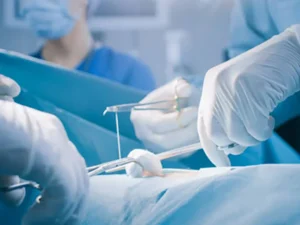 The healthcare system can feel like a whirlwind to patients who, prior to receiving any treatment, must schedule an appointment, complete a pile of paperwork, and take part in a comprehensive health assessment. This is how medical professionals determine the patient’s status and degree of urgency.
The healthcare system can feel like a whirlwind to patients who, prior to receiving any treatment, must schedule an appointment, complete a pile of paperwork, and take part in a comprehensive health assessment. This is how medical professionals determine the patient’s status and degree of urgency.
Done right, this process can provide detailed insights that are invaluable to making an official diagnosis and determining how to proceed with treatment. This can also be a great time to reassure patients and take steps to make them feel as confident and comfortable as possible.
Nurses are heavily involved in this process and enjoy a great deal of autonomy and responsibility when examining patients. Their insights can make a world of difference, boosting everything from patient satisfaction to long-term health outcomes. They are also instrumental in maintaining the general flow of the facility, so physicians can focus on discussing current concerns, making diagnoses, and determining the best course of action for treatment protocols.
Whether you are an aspiring nurse or eager to take your nursing practice to the next level, it is imperative that you understand how patient assessments function and which strategies can be implemented to improve this process. Keep reading to discover everything you need to know when assessing a patient with a medical complaint.
What Is the Importance of the Patient Exam?
The patient assessment forms the basis of any medical visit and can set the stage for accurate diagnoses and impactful care plans. This is a fundamental part of the comprehensive nursing process, which begins with the assessment and continues to include diagnosis, planning, implementation, and evaluation. Assessment allows healthcare workers to gain a better understanding of the patient’s needs, while revealing concerns that might impede effective diagnosis or treatment.
Nurse practitioner Terri Zucchero tells Nurse.org that this process — also known as the head-to-toe assessment — functions as a baseline examination, that can be valuable when discerning “patient health needs, current health status and patient goals for personal health outcomes, including health promotion and wellness counseling.”1
There are multiple types of patient examinations, including:
- Complete health assessments. Delving into patient health history and incorporating head-to-toe exams, these assessments can be performed by registered nurses during home health visits and as patients are admitted to hospitals or clinics. This is also a crucial part of a standard doctor examination of patient health, such as the annual physical examination.
- Problem-focused assessments. This differs considerably from the complete assessment in that it emphasizes a particular body system, rather than providing a comprehensive overview. Problem-focused assessments may be preferable for patients with specific health goals or urgent concerns that need to be addressed promptly.
How Should I Prepare for a New Exam?
Nurses play a central role in every aspect of the standard patient assessment. Specific tasks will depend on the type of facility, the needs of the patient, or the level of nursing — but in general, nurses can expect to take on a variety of responsibilities that begin well before patients even arrive. The following are among the most important steps required when preparing for a patient medical assessment:
Set Up a Clean Room
It’s impossible to overstate the importance of cleaning and organization in the modern healthcare environment. When the goal is to limit healthcare-associated infections (HAIs), strict sterilization procedures are vital. Depending on the scope of the clinic or hospital, these tasks may be handled by licensed practical nurses (LPNs), registered nurses (RNs), or medical assistants (MAs), although all healthcare professionals are expected to follow hygiene protocols.
As experts from the Centers for Disease Control (CDC) explain in the Guide to Infection Prevention, cleaning is an intensive process that involves the “removal of visible soil and organic contamination from a device or environmental surface using the physical action of scrubbing with a surfactant or detergent and water, or an energy-based process.”2
This means that, prior to every new patient’s arrival, all surfaces (especially high-touch areas) within physician offices must be cleaned and disinfected. Common areas of concern include bedrails and doorknobs, but any surface could potentially be a vector for infection.
Furthermore, the CDC highlights the need to clean and maintain reusable devices or tools “according to the manufacturer’s instructions to prevent patient-to-patient transmission of infectious agents.”
The level of disinfection required may be determined according to the Spaulding Classification, which distinguishes critical items (such as surgical instruments), semi-critical items (including endoscopes), or non-critical items (like blood pressure cuffs) and the relevant level of sterilization for each category.
Ensuring All Tools Are Available for the Exam
In addition to disinfecting all reusable tools, nurses should verify that all required items are readily available in time for the exam. These will vary somewhat based on the medical specialty and the patient population, but some tools and equipment are essentially universal and should consistently be on hand. In most cases, the following should be available in any examination room:
- Stethoscope
- Blood pressure cuff
- Penlight
- Reflex hammer
- Otoscope
- Personal protective equipment
Greeting With a Friendly Face
Nurses’ hard work may ensure that physicians’ offices are pristine and organized, but that’s certainly not where pre-exam efforts end. Nurses also need to be prepared to greet and, perhaps, reassure patients.
- A smile and a kind tone of voice can make a world of difference. This is where soft skills such as verbal communication and empathy can prove invaluable. Best practices for greeting patients include:
- Making simple introductions so that patients know the nurse’s name and role.
- Making eye contact with patients and smiling. Remember, facial expressions will be visible even when nurses are required to wear masks during patient exams.
- Engaging in friendly small talk while guiding patients toward the exam room. This is a great opportunity to help patients feel cared for and appreciated — and can also cut through any tension or stress patients may be experiencing.
- Chatting briefly about the patient’s reason for visiting the medical before providing a basic walkthrough of what to expect during the next portion of the patient assessment.
What Should the Patient Experience at the Beginning?
The first stages of any health assessment should center around making patients feel comfortable and gaining insight into their current medical concerns or their reason for visiting. This process should not only feel supportive but also predictable, so patients always know exactly what to expect. Simple routines can put patients at ease, no matter who conducts the health assessment or why it’s needed.
Initial Introductions
Patients may interact with a variety of healthcare professionals during their visit, and without friendly introductions, it can begin to feel overwhelming. As such, each health assessment should begin with a friendly introduction, including your name and role. As Zucchero explains in the previously mentioned Nurse.org guide, “Establishing a personal relationship of trust and respect between the patient and the nurse is vital,” adding that this begins with providing a basic introduction and an overview of the upcoming assessment.
Asking Questions and Addressing Concerns
At the outset of each assessment, nurses should ask a few simple questions about what patients are experiencing and how their condition has evolved over time. How these questions are asked matters as much as what concerns they cover — a friendly, clear tone of voice should be used, including simple language so that patients know what nurses are trying to learn and can therefore provide an accurate response. Concerns worth exploring through targeted questions include:
- Anything that aggravates or alleviates the specific health concern.
- History of the given health issue and any related concerns.
- Past health history, including allergies, hospitalizations, or surgical procedures.
- Current prescriptions or over-the-counter medications.
- Pertinent family history, including details about chronic conditions or genetic disorders.
What Happens Next?
Once a solid rapport has been established and the basic reasons for the visit are understood, it’s time to move on to the next stages of the health assessment. This is when nurses shift from seeking a broad overview to getting much-needed details about the patient’s condition.
These are often best obtained by conducting thorough observations or gathering patient data in the form of vitals, although a subjective assessment of the patient’s appearance and status is also advised. We describe these essentials — and other key steps — in detail below:
Checking Vitals
Vitals can provide powerful insight into the patient’s current health status. These are typically collected and recorded by nurses, often shortly after they have noted basic concerns such as level of alertness or indicators of distress or discomfort. Top examples of vital signs worth obtaining include:
- Pulse rate
- Body temperature
- Rate of breathing
While blood pressure is not, technically speaking, classified as a vital sign, it is typically measured at this stage, as well. As experts explain in Nursing Times, some patients may require measurements both while standing and lying down.3
Comprehensive Assessment of Patient
After the patient’s history and concerns have been noted — and after vitals have been collected and recorded — the nurse can proceed with an in-depth assessment that incorporates diagnostic tests and physical inspections. Areas that call for assessment include:
- Head, ears, eyes, nose, and throat (HEENT).4 This should include PERRLA: pupils are equal, round and reactive to light and accommodation.5
- Neck, including the lymph nodes and trachea, as well as range of motion.
- Respiratory system, including the chest and breath sounds (such as the pitch and duration).
- Cardiac system, assessing for murmurs and listening for heart rate and rhythm.
- Abdomen, touching on concerns regarding the bladder or bowel.
- Pulses of arms, legs, and feet.
- Range of motion in the extremities.
- Skin inspections for lesions, abrasions, or clamminess.
- Neurological evaluation including balance, cranial nerves, and fine motor skills.
Throughout this process, nurses should be mindful of key distinctions between normal and abnormal findings. Typically, the human body can be expected to present as bilaterally symmetrical, so any indications of asymmetry should be cause for concern.
Care Plan With Doctor
While nurses are tasked with gathering relevant information, the doctor or nurse practitioner is ultimately responsible for making the official diagnosis and determining which treatment strategies are required. From there, however, the nurse enjoys considerable autonomy, including the opportunity to develop a care plan with insight and approval for the physician or nurse practitioner.
As a detailed resource on the Nursing Process explains, “Care plans provide a course of direction for personalized care tailored to an individual’s unique needs” with the ultimate goal of enhancing “communication, documentation, reimbursement, and continuity of care across the healthcare continuum.”6
The patient’s current status and comorbid conditions should play into this plan, which should incorporate patient-specific goals that are SMART: Specific, Measurable, Achievable, Relevant, and Time-Bound.
Informing the Patient of Next Steps
Once a care plan has been developed, it’s crucial to explain to the patient what that plan involves and which factors have helped to shape the goals included. How nurses educate and reassure patients may determine whether they ultimately adhere to recommended treatment plans.
Building Patient Rapport
While nurses should strive to build rapport through every stage of the health assessment process, this becomes especially important when reaching the assessment’s conclusion. This means maintaining a friendly attitude and a sense of trust, both of which play heavily into patients’ responses as they are clued in on likely next steps.
Letting Them Know the Next Steps for Treatment
Nurses often play a highly informative role in the continuum of care by letting patients know what they can expect moving forward. This is an excellent opportunity to explain next steps in layman’s terms, using visual aids or other available tools to facilitate greater understanding.
Answering Final Questions
Once they have a basic familiarity with the next steps in their care plan, patients may express curiosity or worry about future medical treatments. Nurses should be prepared to answer these questions or refer patients to their physicians for additional insight. A guide from Oncology Nursing News explains, “By achieving an open dialogue with their healthcare provider, patients can stay connected to the specifics of their care.”7
Make Your Mark in the Healthcare Sector
Learn how to take your place in the medical field with an Associate Degree in Nursing or continue on your nursing path with a Bachelor of Science in Nursing from Carrington College.
Carrington College’s nursing programs provide a broad overview of critical healthcare concepts but may not cover all patient assessment strategies and techniques outlined in this guide.
Sources
- Gaines, Kathleen. “How to Conduct a Nursing Head-to-Toe Assessment.”
- Guide to Infection Prevention for Outpatient Settings: Minimum Expectations for Safe Care Center for Emerging and Zoonotic Infectious Diseases.
- “Blood Pressure 2: Procedures for Measuring Blood Pressure.” Nursing Times, 15 May 2020
- “Head, Eyes, Ears, Nose, Throat (HEENT) Assessment.”
- Villines, Zawn. “PERRLA Eyes: What to Know.”
- Toney-Butler, T. J. Nursing Process.” StatPearls – NCBI Bookshelf.
- “Three ways nurses can ensure patient adherence to treatment regimens.” Oncology Nursing News.



